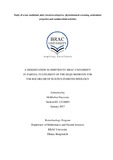| dc.description.abstract | Artemisia nilagirica is an aromatic herbaceous plant belongs to Asteraceae family used in traditional medicine for the treatment of various ailments. Locally the plant is known as Nagdan or Nagdamani. This plant has been reported to be used in treating skin diseases, wounds, ulcers, bronchitis, tuberculosis, epilepsy, and nervous diseases. Artemisia nilagirica is a rare plant in Bangladesh, found only in Sylhet district. Research suggests Nagdana also possesses medicinal properties including antimicrobial, antifungal, and anti-carcinogenic activities. Hence, this study was carried out using locally produced organic green tea. Preliminary screening of the extracts was conducted to identify the presence of alkaloids, flavonoids, steroids, saponins, tannins, phenols, cardiac glycosides, amino acids, terpenoids, anthraquinones and carbohydrates. Three organic solvent extract of Artemisia nilagirica namely, methanolic, ethanolic and chloroformic were screened for phytochemical profiling. Dried leaves with Inflorescences were used for screening of bioactive constituents by standard methods. Phytochemical analyses were carried out to identify the presence of eleven types of bio-active compounds in leaves and florescence. Antioxidant activity of extracts was determined by DPPH free radical scavenging activity with and without buffer. Methanolic extract in buffered solution showed the highest antioxidant activity (92.25% free radical scavenging activity) followed by ethanolic and Chloroformic extract. The lowest % of free Radical scavenging activity is 56.69% in non-buffered Chloroformic exraction. Comparative analysis of the antimicrobial activity of the extracts was investigated against Escheriechia coli, Shigella flexneri, Streptococcus pneumonia, Bacillus subtilis and Staphylococcus aureus along with synergistic activities. Ampicillin, ciprofloxacin, tetracyclin, kanamycin and chloramphenicol discs were used as positive control to measure the antimicrobial activity and synergistic activity of tea extracts and antibiotics. E.coli showed highest antimicrobial activity by representing 58.33% activity index in Ethanolic extract. S. aureus only showed inhibition potency for Chloroformic extracts, while S. pneumoniae showed resistance to it. These phytochemical characterization data along with antioxidant and antimicrobial assay would be helpful in authentication of raw material or crude drug of Artemisia Nilagirica leaves found in Sylhet district. | en_US |

